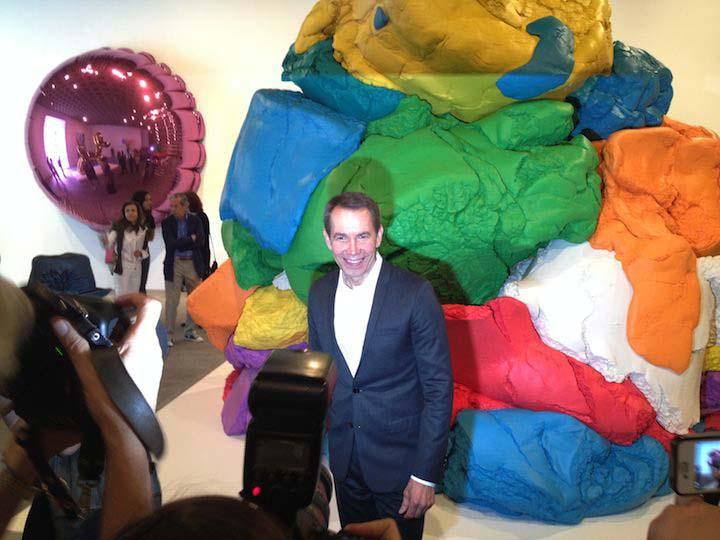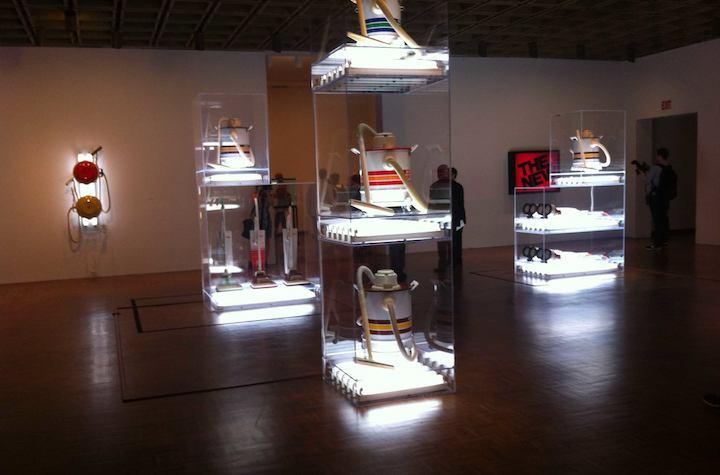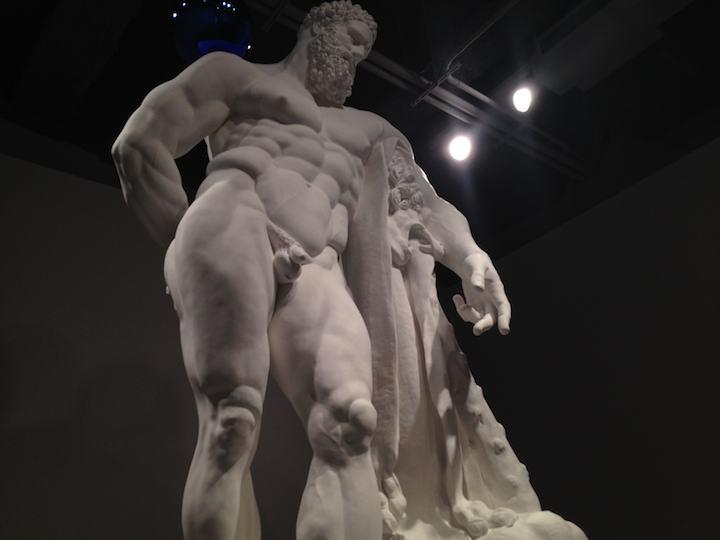Jeff Koons, LLC
Jeff Koons, A Retrospective opens at the Whitney Museum of American Art tomorrow, making a spectacular end point for the museum’s stay on Manhattan’s Upper East Side. The show fills four floors of the Breuer building, plus the lobby gallery. Arranged chronologically, it traces the career of a controversial artist who is alternately cheered and reviled in the art world. Outside of the art world, he barely makes a ripple because the, say 90%, would be clueless as to his game.
Koons came along at a moment when there was so much money floating around
that he conceived an art form that mocks consumer culture, fetishism and fantasy in ways unimaginable during the frolicsome Pop Art days. Emerging as a phenomenon in the 1980s, his ready-mades
(inspired by Marcel Duchamp) comment on the American consumer desire for newer, better, shinier, and costlier stuff. First, vacuum cleaners; later, sex; later still, toys.
The fact
that Koons employs assistants (around 100 at present) is another significant aspect of his strategy. Adopting the business practices of art stars of the Golden Age of Dutch painting (such as
Rembrandt and Rubens), who created works for noble patrons, Koons has flipped the equation and become a corporation in his own right, complete with the attendant media hype of the product
launch.
Jeff Koons at the Media Preview, enjoying the frenzy, with Pla-Doh
behind. Photo: Ward Schumacher.
The Whitney installation makes a perfect commentary on aspects of art transformed by and into commerce, with, as a side effect, art fairs nearly making
galleries redundant. Curated by Scott Rothkopf (who is also the Whitney’s Associate Director of Programs), the sculptures in this exhibition are widely spaced out in the museum’s
high-ceilinged galleries.
In addition to works that have become iconic as much for the prices they bring as for their unusual subjects, such as Balloon Dog, or Michael
Jackson and Bubbles, there are numerous paintings and repurposed and collaged liquor and sports billboards that are pretty forgettable; these are arranged almost like wallpaper backdrops for the
sculpture. Its as if the Frieze Art Fair has moved to Madison Avenue, possibly expanding the commentary on consumerism; actually, delete “possibly”: shipping costs for this show were
astronomical, a fact rather proudly announced by the museum; prouder, still: that a sponsor picked up these costs.
Jeff Koons, works from The New series, ca. 1980s. Photo: Vivienne Flesher.
The influence that Koons has had on—or has taken from—younger artists is evident in the show; among others, Rob Pruitt, Takashi Murakami and Yoshitomo Nara come to mind. The newest piece, on the 4th floor, which took 20 years to complete and is being seen for the first time, is Pla-Doh. This giant mound of kid stuff, enlarged beyond imagination, is crafted of cast aluminum, exquisitely painted in super-saturated Crayola colors. One thinks of Paul McCarthy—but this ain’t shit.
Among the newest pieces
is a colossal replica of the Farnese Hercules, an often-copied ancient sculpture from the Roman Baths of Caracalla. The quease-inducing ugliness of this version is nearly outshined by the
technical virtuosity of its execution—another of the artist’s much-discussed strategies. Without knowing that it is modeled on cheap souvenirs obtainable at historic sites in Italy, and
fabricated by a concern that specializes in replication, it’s hard to get what’s going on here. The figure recalls the classical marble original in its overall look, and makes reference to
plaster replicas in its finish. However, the figure’s left hand is grotesquely out of proportion in a way that would never be noticed in a small souvenir. By mocking a trashy souvenir that an
art ignorant tourist might treasure, while making an art object that would sell for millions, the artist is skewering just about everyone in the art world food chain, himself included.
Jeff Koons, Farnese Hercules (2013). Photo: Peggy Roalf.
Jeff Koons: A Retrospective, is a must see, and you must attend with a friend or two to get a good conversation going about the state of art, culture, and commerce today. One
of the important contributions the exhibition will make is this: It is not necessary to know anything about art to take in the show and discuss what one sees. It is likely to inspire dialogue both
high and low and to make people think about what rises, and why.
The Whitney Museum of American Art, 945 Madison Avenue at
75th Street, NY, NY. The exhibition continues through October 19, after which it will travel to Centre Pompidou, Paris, then to the Guggenheim Museum Bilbao.
On Sunday, June 29, curator Scott Rothkopf and author Rachel Kushner will give a talk at
at 6:30 pm.
This summer, Jeff Koons's Split-Rocker is installed at Rockefeller Center, presented by Gagosian Gallery and organized by Public Art Fund and Tishman Speyer, Split-Rocker is a planted replica of the polychromed aluminum piece in the Whitney exhibition that towers over 37 feet high and features over 50,000 flowering plants.


